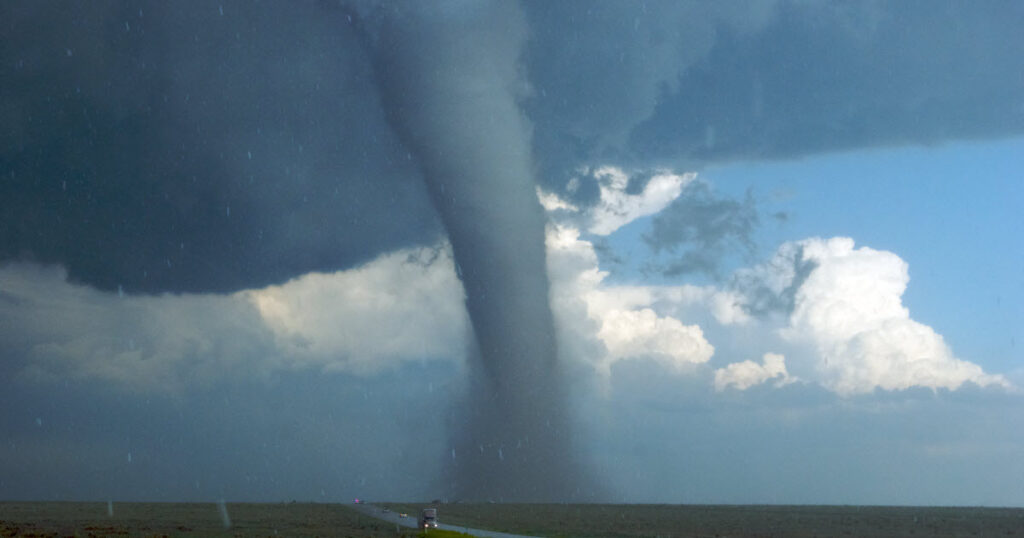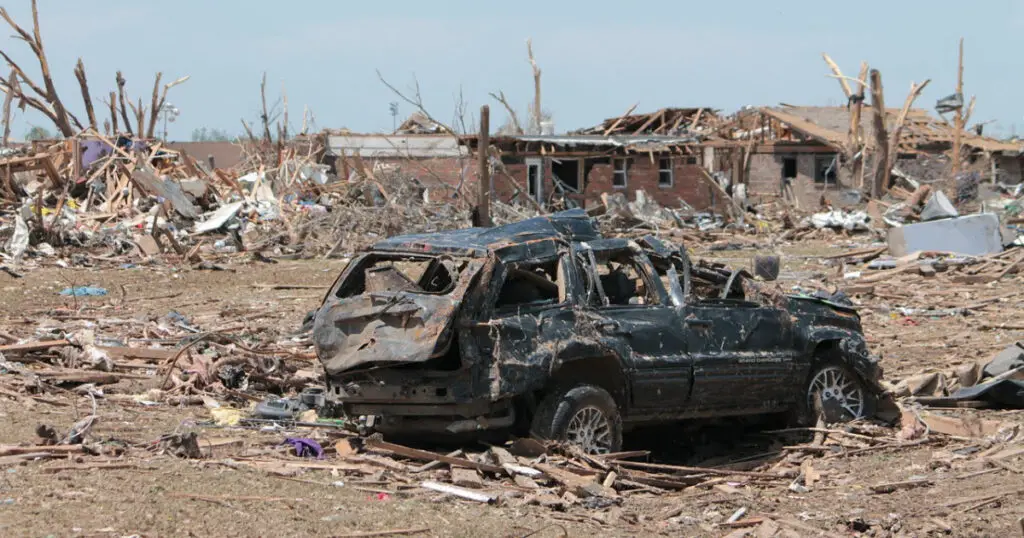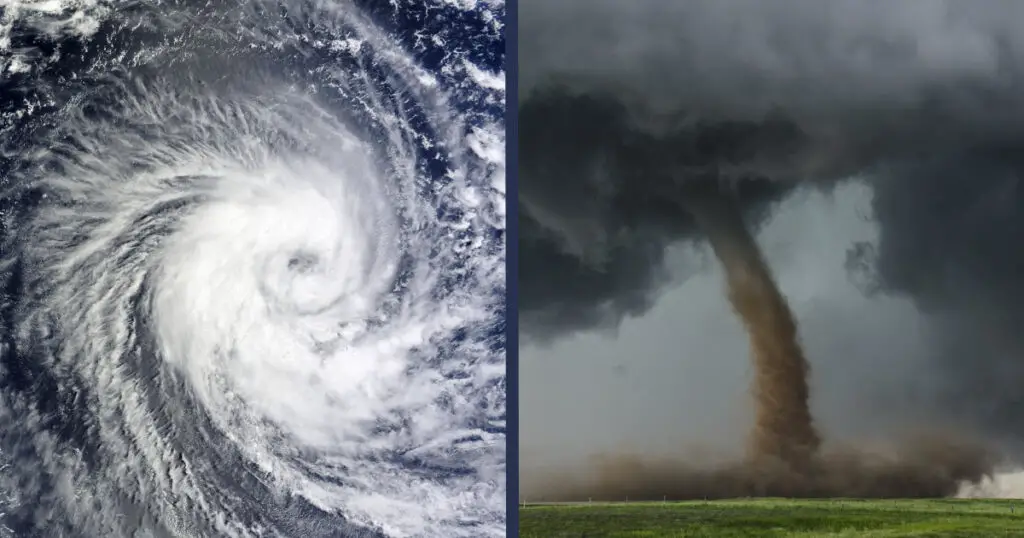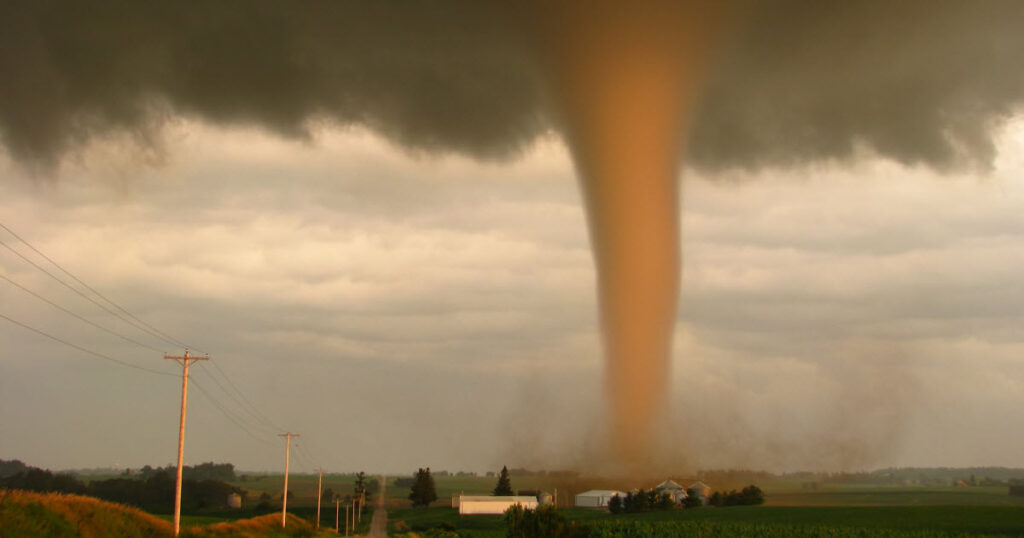Also called twisters, tornadoes are an extreme weather phenomenon that consist of high, spinning winds that form a funnel shaped structure. When a tornado occurs, it can cause massive devastation. It can destroy homes and buildings, uproot trees and vegetation, and hurl anything it comes into contact with hundreds of meters across the ground. It may also result in many injuries and loss of life. But how fast do tornadoes spin? Are some tornadoes more deadly than others because of greater wind speeds? We’ll examine these questions in this article.
A tornado often comes with rain or hail and is accompanied by a loud, howling sound.
They form when moist, warm air collides with cold, dry air. Typically, the denser cold air pushes over the warm air, creating a thunderstorm. But when warm air rises through the cold air, it gains speed and causes an updraft. When more air and moisture is swept up into updraft, it will swell and form a rotating funnel at its center, called a vortex.
Meanwhile, the downdraft of cold air then meets the funnel’s upward spiral. With enough pressure and weight, the funnel cloud will continue to grow and eventually move toward the ground, becoming a tornado.
So, How Fast do Tornadoes Spin?
Tornadoes vary in intensity, size, and appearance. Wind speeds may range from 65 mph to more than 300 mph. The Enhanced Fujita (EF) Scale is used in classifying tornadoes according to estimated wind speed and damage. It is composed of six categories which start with EF0 (gusts from 65-85 mph) and end with EF6 (gusts from 200 mph) classifying the wind speed.
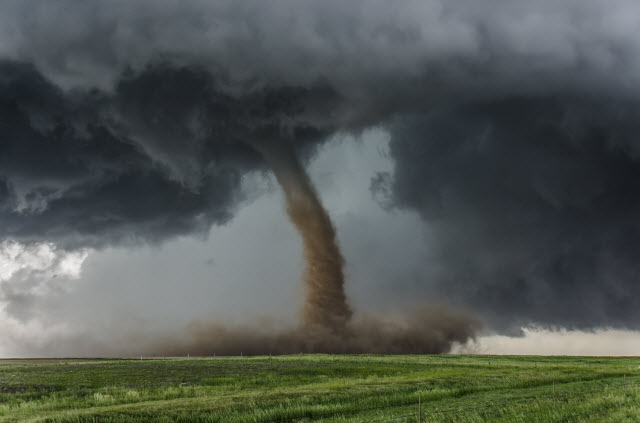
A tornado’s EF rating is not confirmed until the National Weather Service has surveyed the area hit by the tornado and the damage it caused. A total of 28 damage indicators are used to observe the extent of damage, and then matched to the tornado wind speed scale. The indicators include damage to properties, infrastructure, and wildlife, among many others.
| Enhanced Fujita Scale (EF) Rating | Description | 3 Second Gust (mph) | Typical Damage |
|---|---|---|---|
| 0 | Mild Damage | 65 to 85 | Peels surface off some roofs; some damage to gutters or siding |
| 1 | Moderate Damage | 86 to 110 | Roof severely stripped, mobile homes overturned or badly damaged, loss of exterior doors, windows, and other glass broken |
| 2 | Considerable Damage | 111 to 135 | Roofs torn off well-constructed homes destroyed |
| 3 | Severe Damage | 136 to 165 | Entire stories of well-constructed homes destroyed; severe damage to large buildings such as shopping malls |
| 4 | Extreme Damage | 166 to 200 | Well-constructed houses and whole-frame homes completely leveled |
| 5 | Incredible Damage | Over 200 | Strong frame houses leveled off foundation and swept away; high-rise buildings have significant destruction |
In Which Direction do Tornadoes Spin?
Tornadoes spin either clockwise or counter-clockwise, but it would depend on which hemisphere you’re on. In the northern hemisphere, tornadoes spin counterclockwise or similar to the direction as a cyclone, while in the southern hemisphere, tornadoes spin in a clockwise direction.
The Coriolis effect or Coriolis force influences why tornadoes spin in an anti-clockwise direction in the northern hemisphere. As the Earth rotates on its axis, it deflects any object that flows or flies above the surface. The angle of deflection caused by the Coriolis effect depends on the location of the moving object, in this case, currents of air. In areas north of the equator, the Coriolis force deflects flowing air to the right.
| Related Posts |
|---|
Where do Tornadoes Occur?
Tornadoes occur in many places around the globe. They typically form in areas that experience severe thunderstorms. Countries like Australia, France, Spain, Argentina, Brazil, Japan, and China are among the countries that get tornadoes every year. The United States is the country with the highest frequency of tornadoes, with about a thousand tornadoes hitting each year.
In the US, tornadoes happen in every state. However, they frequently appear in an area called the “Tornado Alley”, found in the Great Plains of central USA. This region is between the Rocky Mountains and the Appalachian Mountains. It encompasses the states of Texas, Oklahoma, Kansas, Missouri, and parts of Louisiana, Iowa, Nebraska, and Colorado.
The Dixie Alley, which includes parts of Arkansas, Tennessee, Alabama, and Georgia, is another US region that gets its share of tornadoes every year. Florida is the most tornado-prone state outside the Tornado Alley and Dixie Alley because of its frequent thunderstorms.
What Affects Tornado Formation?
Areas hit by frequent thunderstorms are conducive to tornado formation. We have an in-depth article about how tornadoes form, but in short the following conditions may be present in such areas:
Unstable Atmospheric Conditions
In a stable atmosphere, warm or humid air is at the lower layers of the atmosphere. Atmospheric instability occurs when the air is warmer than the surrounding air.
When this happens, warm air rises and may cause extreme weather changes. Rising air may also cause water vapor in the air to condense and form clouds. Condensation also releases heat, which causes warm air to rise even higher and increases the likelihood of thunderstorm and tornado development.
Competing Air Masses
In the Tornado Alley, when warm, wet air from the Gulf of Mexico meets dry, cold winds from the Canadian tundra, the warm air pushes itself in an upward spin and causes cool air to spiral downwards. When the two competing air masses spin faster, it forms a tornado.
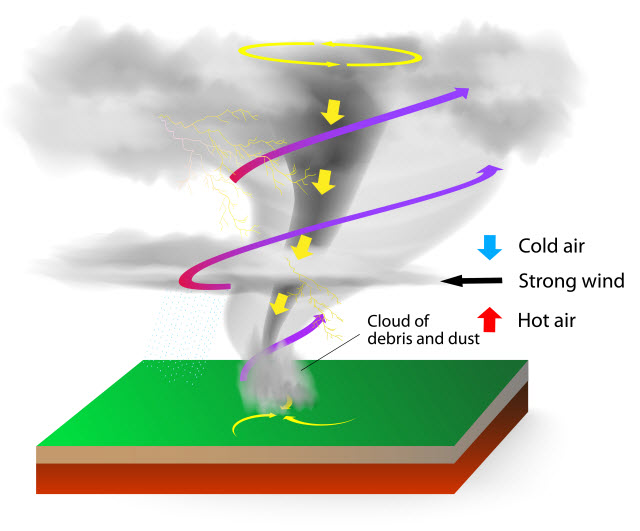
Flat, Dry Terrain
Tornadoes may travel through mountains and even over bodies of water (waterspouts). However, they are most likely to form easily in plains or open and flat stretches of land.
When do Tornadoes Strike?
Tornadoes can happen at any time of the year.
In the southern states, the peak months of tornado activity are April, May, and June.
Tornadoes also occur more frequently in the afternoon when atmospheric conditions are more conducive to supercell thunderstorm formation.
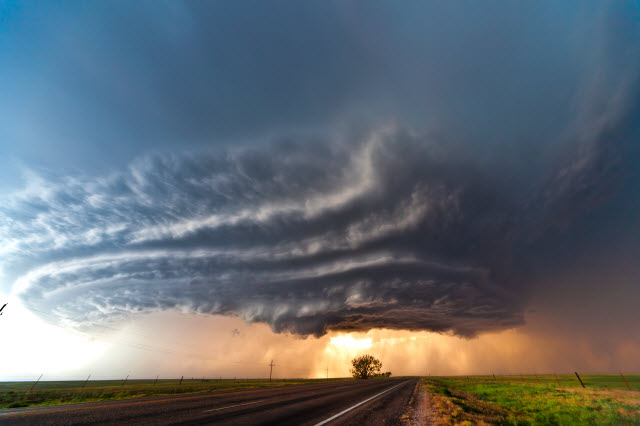
Worst F/EF5 Tornadoes in the US and the World
As shown in the Enhanced Fujita scale above, tornadoes with EF5 rating are the strongest and deadliest. While tornadoes occur in many countries in almost all continents (except Antarctica), only the US and Canada have verified reports of EF5 tornadoes. Below are the worst EF5 tornadoes in US History:
| Event | Date | State(s) Affected | *Wind Speed | Damage Recorded |
|---|---|---|---|---|
| The Tri-State Tornado | March 25, 1925 | Missouri, Illinois, and Indiana | Over 300 mph in some areas | The mile-wide tornado had a damage path of 219 miles long through the three states. The recorded death toll was at least 695 people. |
| The Monster Tornado | April 9, 1947 | Texas, Oklahoma, and Kansas | Over 200 mph in some areas | This tornado was among the widest and largest tornadoes in US record, with a path reaching up to two miles wide and 170 miles long through Texas and Oklahoma. It killed 181 people. The town most impacted was Woodward, Oklahoma, where 107 reportedly died. |
| The Tupelo | April 5, 1936 | Mississippi, Arkansas, and South Carolina | Over 300 mph in some areas | The two-day outbreak led to 454 deaths, 216 of which were from Tupelo, Mississippi. Another 203 lives were lost the following day, when an F4 tornado hit Gainesville, Georgia. |
| The Joplin | May 22, 2011 | Missouri | Over 300 mph in some areas | This EF5 tornado resulted in 158 fatalities and over a thousand injuries. |
| The New Richmond | June 12, 1899 | Wisconsin | Over 200 mph in some areas | Also called the Circus Day Tornado, this EF5 tornado originated as a waterspout on Lake St. Croix, and then moved northeast toward New Richmond. A total of 117 perished, while approximately 200 were injured in the tornado’s 45-mile long path. |
Recent History and Other Tornadoes of Note
The most recent EF5 tornado that struck the US was on May 20, 2013 in Moore, Oklahoma. It claimed over 20 lives. It left a 17-mile long and 1.3-mile wide path of destruction.
Outside the US, the single deadliest tornado recorded in the world occurred in the Manikganj district of Bangladesh on April 26, 1989. According to the World Meteorological Organization, the tornado hit two towns leaving about 80,000 people homeless and an estimated death toll of 1,300 people.
